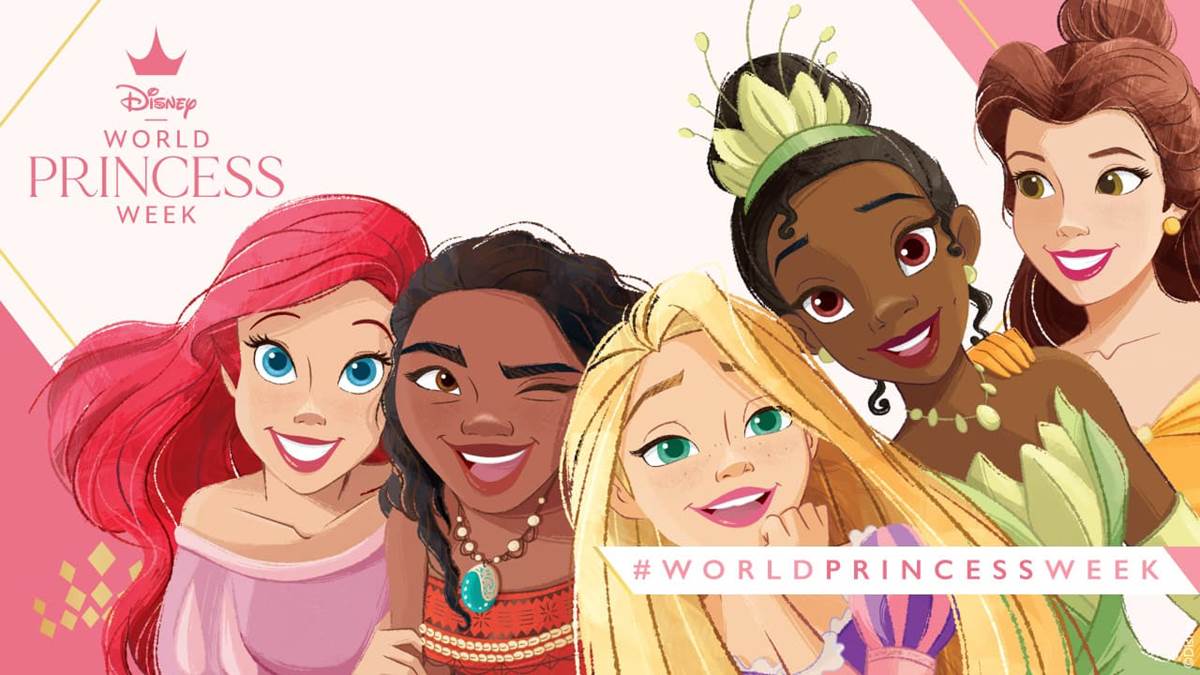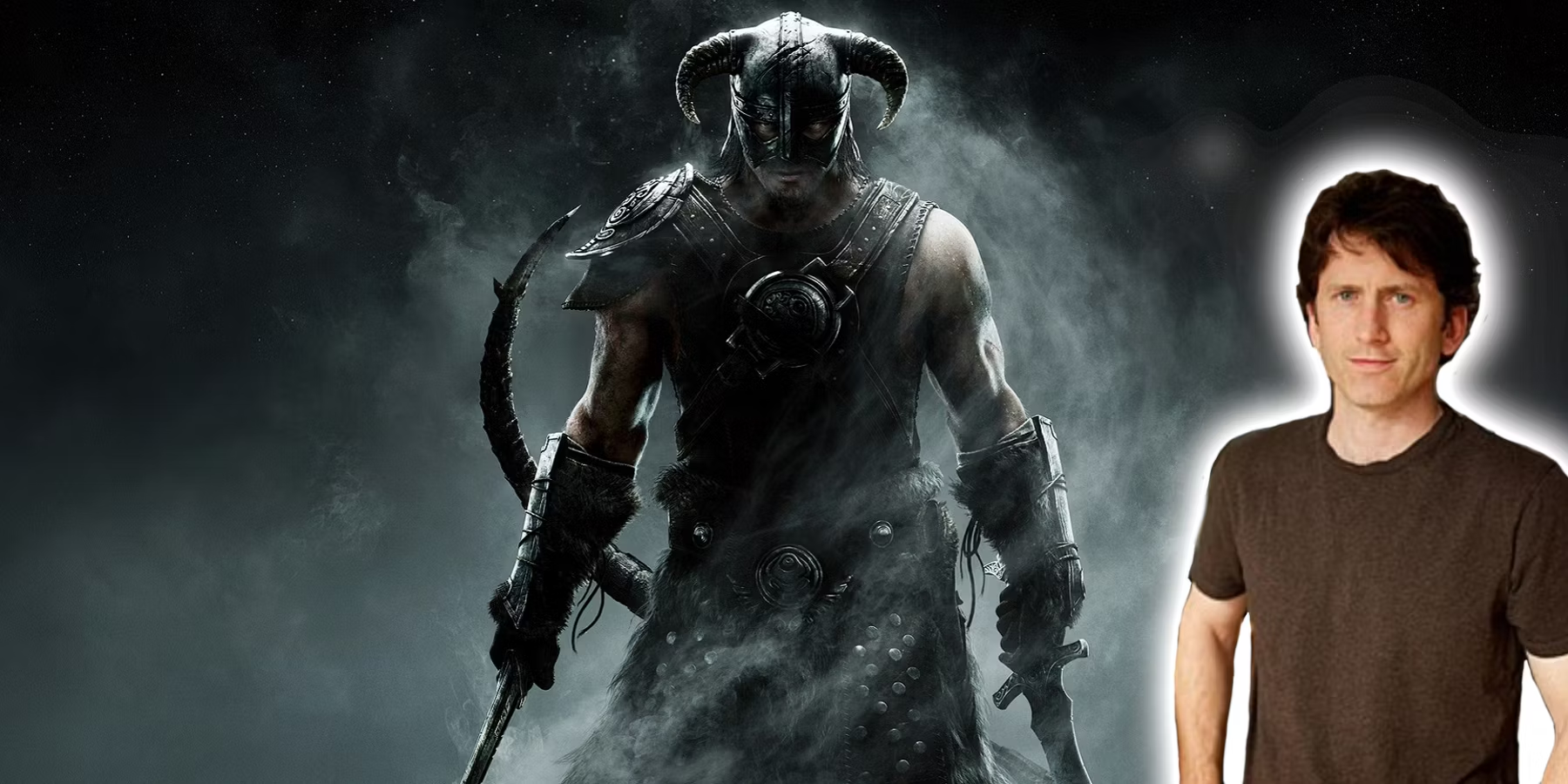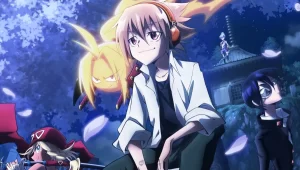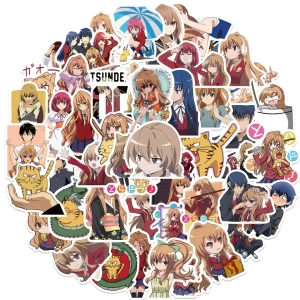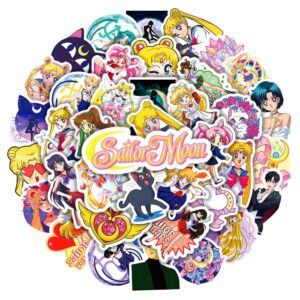This week in video game history – A spiritual successor to the System Shock series begins, what would become almost every child’s favorite sleepover game lands on N64, Mario gets behind the wheel, and the developer of the mighty Space Invaders arcade game is founded.

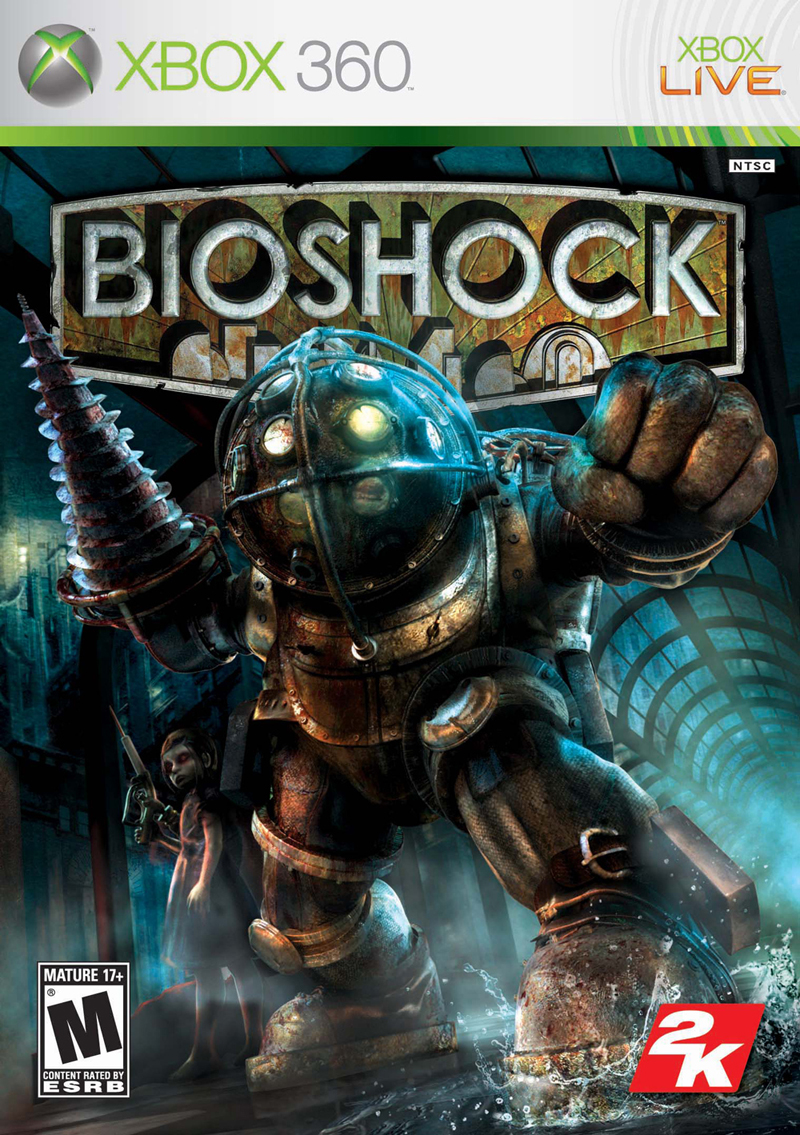
On August 21st, 2007, BioShock is released on PC and Xbox 360 to immense critical acclaim. It would spawn two sequels, two novels and potentially a future movie adaptation. Almost a year later, it would be ported to PS3.
BioShock is a sci-fi first person shooter by Irrational Games and 2K Games with a steampunk theme and visual design inspired by Art Deco and 1950’s style.
The game takes place in a massive fictional underwater city called Rapture, an attempt to create a capitalistic dream society free from religious and government influences.
The story begins in 1960, where our protagonist, Jack, the sole survivor of a plane crash, fortuitously discovers the entrance to the city of Rapture. However, upon entering, Jack soon realizes that Rapture is currently much less of a utopia than its creator had envisioned having survived a civil war.
Before the creation of Bioshock, Lead Designer Ken Levine had attempted to create a sequel to a previous work – System Shock 2. The idea was pitched to Electronic Arts. Sadly, it would be rejected due to a poor sales performance of System Shock 2, despite critical success. Irrational Games would create several titles before Ken Levine returned to his original wish, to create a new game in the style of the System Shock series. After some time, the development team not only created a game which they believed to be too far removed from their original design goals but one for which they were struggling to find a publisher. It was considered to cease its production. Although, as word spread in video game publications that Irrational Games were working on a “spiritual successor” to System Shock 2, Irrational continued production to seize this opportunity and completely revamped their original creation.
One of the original settings for Bioshock was an unearthed World War II-era Nazi experimental research laboratory. In this lab, abandoned genetic experiments had survived and divided into three sub-groups much like those encountered in Bioshock: Little Sisters, Big Daddies, and Splicers.
Lead Designer and Director Ken Levine makes a mini cameo in Bioshock. Scattered throughout Rapture are the ammunition and health boost dispensing Circus of Value labeled vending machines. The clown that greets the player when interacting with the machines is voiced by Ken Levine himself.
Bioshock characters the Little Sisters have become one of the series staples. The glow-eyed and eerie small girls had originally looked significantly more grotesque. The Little Sisters were originally creatures akin to sea slugs called Gatherers. Though it was discovered that test players had little empathy for these slimy beings so the Gatherers were redesigned several times before arriving on the appearance of adorable little girls, two previous design ideas included a dog in a wheelchair and an utterly bizarre frog concept that became known amongst the design team as simply “the frog with a tunnel in its butt”.



On August 25th, 1997, Rare released GoldenEye 007. Due to the success of Donkey Kong Country, GoldenEye007 was originally conceived as a 2D side scrolling action platformer for the Super NES. It would be later suggested that GoldenEye would become a 3D shooter for Nintendo’s next console in development, the Nintendo 64. It would then be reconceived as a rail shooter much like Sega’s Virtua Cop. Eventually, it would become a first person shooter and in time one of the best selling games for Nintendo’s new platform.
GoldenEye 007’s campaign closely follows the plot of the James Bond GoldenEye movie, with some minor differences. While being a competent first person shooter, it was the game’s impressive multiplayer deathmatch mode and it’s bond film inspired game types that caught the attention of young gamers everywhere. Not only that, it helped solidify the humble home games console as a viable platform for future first person shooters.
One of the interesting facts about GoldenEye 007 regards its development team. The majority had never worked on a video game before. At one time during the development of GoldenEye, it was suggested that players would remove and re-insert the N64 controllers Rumble Pak as a unique reloading mechanic. A nice idea but one that Nintendo did not approve of.
GoldenEyes famous deathmatch mode was certainly the game’s most popular feature. Although, it was only added as a mere afterthought much later in its development. Little did Rare know what a huge impact it would make. Not only on unit sales but on the whole video game market.
Hidden in the code of every copy of GoldenEye 007 is an experimental fully functional ZX Spectrum emulator with 10 games created by Rare. It was deactivated in the final build but can still be accessed through the use of fan-made patches.

On August 27th, 1992, Super Mario Kart landed in Japan, kicking off the Mario Kart series and becoming the Super Nintendo’s 4th best-selling title.
While it wasn’t the pioneer of vehicular combat (that honor belongs to Taito’s 1976 title Crash Racing), Super Mario Kart is often credited as the first ever kart racing game. SMK’s success would inspire many kart racers such as Sonic Drift, Street Racer, Wacky Wheels and Crash Team Racing.
Super Mario Karts simple gameplay is what makes it so appealing, addictive and playable. It spawned eight home console follow ups and four arcade games, the Mario Kart GP series. While many of its follow ups would be considered far superior, SMK still holds up and was a phenomenon of its time, no doubt thanks to the overseeing of creator Shigeru Miyamoto. SMK showcases a graphical technique known as Mode 7, this visual technique allowed for the scaling and moving of backgrounds creating a sense of perspective and depth not felt in earlier video games. Though this was showcased by earlier racer F-Zero, it would amaze way more people thanks to the well established Mario franchise.
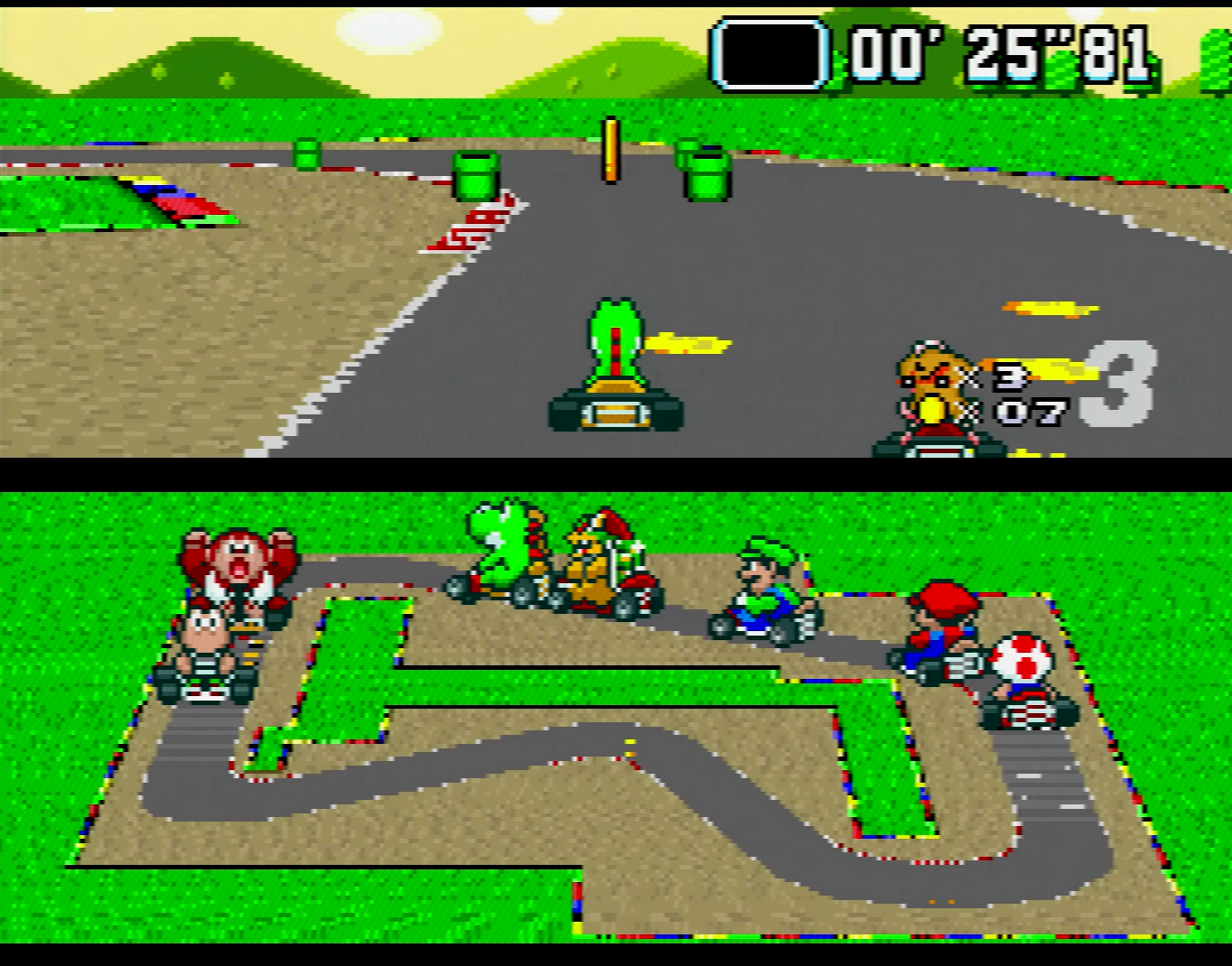 Born of a simple goal to create a multiplayer racing game that displayed two characters on screen simultaneously, Miyamoto and his crew struggled to execute their vision of their then nameless kart racer in the face of hardware limitations presented by the Super NES. Choosing at all costs to not sacrifice this multiplayer function, the crew looked to make reductions elsewhere. One of the most evident is the low detailed and simplistic race tracks.
Born of a simple goal to create a multiplayer racing game that displayed two characters on screen simultaneously, Miyamoto and his crew struggled to execute their vision of their then nameless kart racer in the face of hardware limitations presented by the Super NES. Choosing at all costs to not sacrifice this multiplayer function, the crew looked to make reductions elsewhere. One of the most evident is the low detailed and simplistic race tracks.
As well as Multiplayer, game modes such as Battle Mode were also paramount from day one. The desire would be to create alternate game modes where ranking didn’t factor. In its early phase (much like Super Smash Bros.) SMK did not involve Mario or any other Nintendo franchises or established characters. It would be a few months after development began when characters from the Mario franchise were suggested as potential racers. In fact, Mario entered development just to see how he would look in the kart as a second competitor when the player passes him during a race. It was concluded that Mario looked better than their basic original racer design. It was at this point when the idea for a Mario racing game was born.
Did you know? That Super Mario Kart takes place within the specific universe of Super Mario World, not its own island or location. In fact, it takes place on Dinosaur Island. Lakitu, the cloud-riding, chequered flag-waving turtle apparently owns all the tracks.
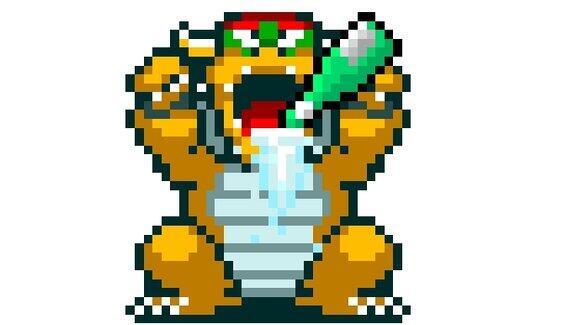
CHUG CHUG CHUG CHUG!!
If you were to win a race as either Bowser or Princess Peach in SMK’s North American version they would celebrate, by throwing a champagne bottle in the air (what a stupid thing to do!) However, in the Japanese version, Bowser and Peach are more inclined to down the whole bottle in drunken jubilations. It was changed for the North American release due to strict standards regarding the depictions of alcohol consumption.

On August 24th way back in 1953, the Japanese video game developer and publisher, Taito Corporation was founded by businessman Michael Kogan. Starting (much like Sega) as a distributor and importer of arcade hardware.
Interestingly, Taito was also the first distiller and distributor of Vodka in Japan.
Up until the 60’s and after a stint selling Jukeboxes, and then the production of their own, Taito began manufacturing its own electro-mechanical amusement machines. Taito would eventually create their first video arcade game in 1973, it would then be 5 years until one of Taito’s talented designers, Tomohiro Nishikado, kicked off the golden era of the arcade by creating a phenomenon – Space Invaders.
-1459049031.png)
Space Invaders (1978)
It would then take until 1986 for Taito to even approach the level of success represented by Space Invaders when two adorable bubble dragons attempt to rescue their kidnapped girlfriends from the cave of monsters in Bubble Bobble.
In 1992, and in a joint venture with a network television company called JSB and a satellite communications company called ASCII, Taito explored the world of video game consoles. Their console design, like SNK’s Neo Geo, was intended to play near-exact ports of arcade games, especially those from Taito. It also had the capability of downloading games. The machine had been called the WOWOW, named for a Japanese television station owned by JSB. It would be via this TV stations satellite data stream that the machine would’ve downloaded its games. In 1992, downloading games would’ve been a phenomenon, even if these games would be stripped down. For demonstrations, Taito created a stripped down version of side scrolling shoot em up Darius.
The demo model of the sleek Taito WOWOW

The WOWOW was designed to play CD titles, download games and offer perfect arcade ports.
Sadly, the machine would never be released. The reasons for its cancellation was, despite reductions in game file sizes, the transmission of games being still too slow. The other issue would be cost estimations. The project team wanted to combine arcade hardware in the home satellite receiver. This meant for the requirement of extra memory and memory at this time was very expensive. This combined receiver meant the WOWOW would’ve cost way too much to produce and so the project was suspended at this point. In 1995, Nintendo arrived with the Satellaview, an add-on with similar technology for their Famicom console. The WOWOW project was pretty much canceled before then. When Nintendo struggled to make a success of their Satellaview, it’s likely that Taito saw this as a warning that such technology was maybe a little too ahead of its time. Regardless, the WOWOW project was over.
In 2000, Taito merged with Japanese electronics manufacturer Kyocera and then in 2005 would virtually disappear being absorbed by Square Enix.




